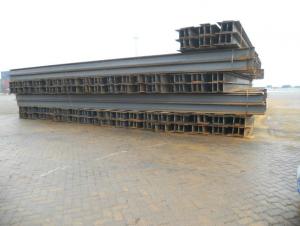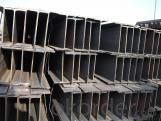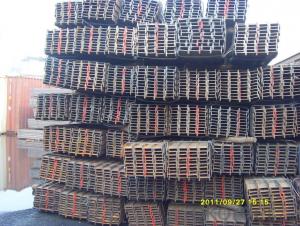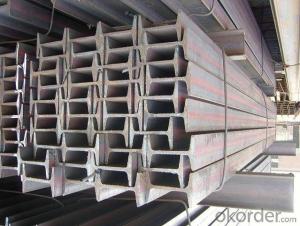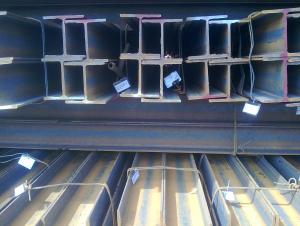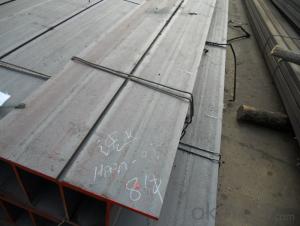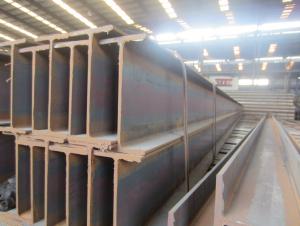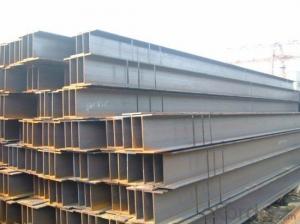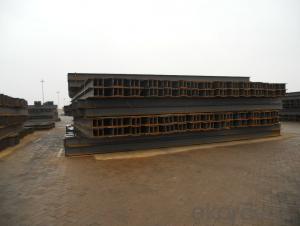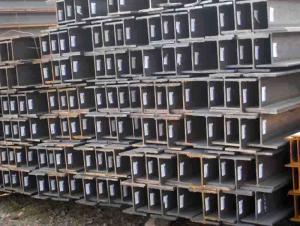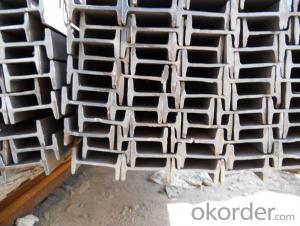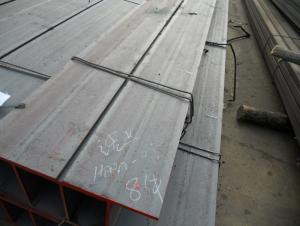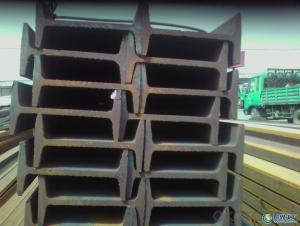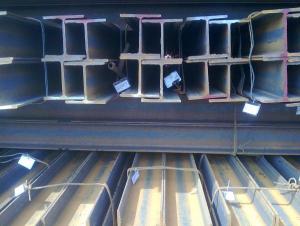Hot Rolled Structural Steel H Beam SS400
- Loading Port:
- Tianjin
- Payment Terms:
- TT or LC
- Min Order Qty:
- 100 m.t.
- Supply Capability:
- 100000 m.t./month
OKorder Service Pledge
OKorder Financial Service
You Might Also Like
Product Description:
OKorder is offering Hot Rolled Structural Steel H Beam SS400 at great prices with worldwide shipping. Our supplier is a world-class manufacturer of steel, with our products utilized the world over. OKorder annually supplies products to European, North American and Asian markets. We provide quotations within 24 hours of receiving an inquiry and guarantee competitive prices.
Product Applications:
Hot Rolled Structural Steel H Beam SS400 are ideal for structural applications and are widely used in the construction of buildings and bridges, and the manufacturing, petrochemical, and transportation industries.
Product Advantages:
OKorder's Hot Rolled Structural Steel H Beam SS400B are durable, strong, and resist corrosion.
Main Product Features:
· Premium quality
· Prompt delivery & seaworthy packing (30 days after receiving deposit)
· Corrosion resistance
· Can be recycled and reused
· Mill test certification
· Professional Service
· Competitive pricing
Product Description:
Specifications of Hot Rolled Structural Steel H Beam
1. Standard: GB700-88, Q235B2.
2. Grade: Q235, SS400 or Equivalent
3. Length: 6m,10m, 12m as following table
4. Invoicing on theoretical weight or actual weight as customer request
5.Payment: TT or L/C
Usage & Applications of Hot Rolled Structural Steel H Beam
Commercial building structure ;Pre-engineered buildings; Machinery support structure; Prefabricated structure; Medium scale bridges; Ship-building structure. etc.
Packaging & Delivery of Hot Rolled Structural Steel H Beam
1. Packing: it is nude packed in bundles by steel wire rod
2. Bundle weight: not more than 3.5MT for bulk vessel; less than 3 MT for container load
3. Marks:
Color marking: There will be color marking on both end of the bundle for the cargo delivered by bulk vessel. That makes it easily to distinguish at the destination port.
Tag mark: there will be tag mark tied up on the bundles. The information usually including supplier logo and name, product name, made in China, shipping marks and other information request by the customer.
If loading by container the marking is not needed, but we will prepare it as customer request.
4. Transportation: the goods are delivered by truck from mill to loading port, the maximum quantity can be loaded is around 40MTs by each truck. If the order quantity cannot reach the full truck loaded, the transportation cost per ton will be little higher than full load.
5. Delivered by container or bulk vessel
Production flow of Hot Rolled Structural Steel H Beam
Material prepare (billet) —heat up—rough rolling—precision rolling—cooling—packing—storage and transportation
FAQ:
Q1: Why buy Materials & Equipment from OKorder.com?
A1: All products offered byOKorder.com are carefully selected from China's most reliable manufacturing enterprises. Through its ISO certifications, OKorder.com adheres to the highest standards and a commitment to supply chain safety and customer satisfaction.
Q2: Can fit in the containers of 20fts the steel beams of 6M?
A2: No proble, we can put them into the containers in the form sideling.
Q3: The products are invoicing on theoritical weight or on actual weight?
A3: We can do it in both manners, according to the customers' request.
Images:
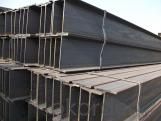
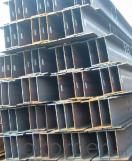
- Q: What are the design considerations when using steel H-beams in buildings?
- Some key design considerations when using steel H-beams in buildings include the load-bearing capacity of the beams, the structural stability they provide, their resistance to bending and deflection, and their ability to support other building elements such as floors and walls. Additionally, factors such as the required span length, the building's intended use, and any specific architectural or aesthetic requirements must also be taken into account during the design process.
- Q: Are steel H-beams fire-resistant?
- Yes, steel H-beams are fire-resistant. Steel is an inherently fire-resistant material due to its high melting point and low flammability. H-beams, being made of steel, can withstand high temperatures and retain their structural integrity during a fire.
- Q: Can steel H-beams be used for railway bridges or overpasses?
- Yes, steel H-beams can be used for railway bridges or overpasses. Steel H-beams are commonly used in construction due to their high strength-to-weight ratio, making them suitable for supporting heavy loads. Railway bridges and overpasses require strong and durable materials to support the weight of trains, and steel H-beams are well-suited for this purpose. They provide structural stability, can withstand high loads and forces, and have the ability to span long distances. Additionally, steel H-beams are resistant to corrosion, which is important for structures exposed to the elements. Overall, steel H-beams are a popular choice for railway bridges and overpasses due to their strength, durability, and versatility.
- Q: How do steel H-beams perform in terms of creep resistance?
- The outstanding creep resistance of steel H-beams is widely recognized. Creep refers to the material's tendency to deform under constant stress over time. Steel H-beams are designed specifically to bear high levels of stress and maintain their structural integrity for extended periods. The H shape, combined with the properties of steel, endows these beams with exceptional resistance to creep. The H shape enhances strength and rigidity, enabling the beam to evenly distribute the load and prevent localized deformation. Moreover, steel itself is a highly durable material renowned for its remarkable creep resistance. Steel H-beams find extensive use in construction projects demanding long-term stability and load-bearing capacity. They are commonly employed in the construction of bridges, high-rise buildings, and industrial structures. The ability of steel H-beams to withstand creep ensures that these structures can endure constant stress over many years. It is worth noting that while steel H-beams generally exhibit excellent creep resistance, their specific performance can vary depending on factors such as the grade of steel used, the loading conditions, and the environmental factors present. Nonetheless, steel H-beams are generally regarded as a reliable and durable choice for applications that require crucial creep resistance.
- Q: Can steel H-beams be used in residential garage or carport structures?
- Yes, steel H-beams can be used in residential garage or carport structures. Steel H-beams are commonly used in construction due to their strength and durability. They provide excellent structural support and can withstand heavy loads. Additionally, steel H-beams are resistant to warping, twisting, and shrinking, making them ideal for long-term use in residential structures. Moreover, using steel H-beams in garage or carport structures allows for more open and flexible floor plans, as they eliminate the need for interior load-bearing walls. Overall, steel H-beams are a reliable and efficient choice for residential garage or carport structures.
- Q: Can steel H-beams be used for overhead crane systems?
- Yes, steel H-beams can be used for overhead crane systems. Steel H-beams are commonly used as the main structural support for overhead crane systems due to their high strength and durability. The H-shaped cross-section of the beam provides excellent load-bearing capabilities, making it suitable for supporting heavy loads and withstanding the dynamic forces experienced during crane operations. Additionally, steel H-beams can be easily connected and assembled to create the required crane structure. Overall, steel H-beams are a popular choice for overhead crane systems due to their reliability and suitability for heavy-duty applications.
- Q: Can steel H-beams be used in gymnasium structures?
- Certainly, gymnasium structures can incorporate steel H-beams. Thanks to their robustness and durability, steel H-beams are frequently employed in construction projects. They offer remarkable stability and support, rendering them ideal for expansive areas such as gymnasiums. Furthermore, steel H-beams can be readily tailored and fabricated to meet the precise design prerequisites of a gymnasium. They possess the ability to endure substantial loads and guarantee the essential structural integrity requisite for gymnasium structures.
- Q: What are the welding requirements for steel H-beams?
- The welding requirements for steel H-beams are determined by several factors including the specific steel grade, the thickness of the beams, the type of welding process being used, and the intended application of the beams. Firstly, it is important to select the appropriate steel grade for the H-beams. Commonly used steel grades for H-beams include ASTM A36, ASTM A572, and ASTM A992. These grades have different mechanical properties and welding characteristics, so it is crucial to consult the manufacturer's specifications or relevant welding codes to determine the suitable steel grade for the specific application. Next, the thickness of the H-beams is an important factor that affects the welding requirements. Thicker beams may require preheating before welding to control the cooling rate and minimize the risk of hydrogen-induced cracking. Preheating temperatures and durations should be determined based on the steel grade and thickness, and the specific welding code being followed. The type of welding process being used is another crucial consideration. Common welding processes for H-beams include shielded metal arc welding (SMAW), gas metal arc welding (GMAW), and flux-cored arc welding (FCAW). Each process has its own set of requirements in terms of electrode selection, welding parameters, and post-weld heat treatment. Proper fit-up and joint preparation are also important for achieving high-quality welds on H-beams. The beams should be properly aligned and positioned to ensure full penetration of the weld and minimize distortion. Joint preparation, such as beveling or grinding, may be necessary to achieve appropriate groove dimensions for certain welding processes. Additionally, it is important to consider any specific requirements for post-weld heat treatment or inspection. Some applications may require stress relieving or annealing of the welded H-beams to improve their mechanical properties or reduce residual stresses. Nondestructive testing methods, such as ultrasonic or magnetic particle inspection, may be necessary to ensure the integrity of the welds. Overall, the welding requirements for steel H-beams are dictated by the steel grade, beam thickness, welding process, and application. It is essential to consult relevant welding codes, manufacturer specifications, and engineering professionals to determine the specific welding procedures, parameters, and quality control measures necessary to achieve reliable and structurally sound welds on H-beams.
- Q: Are steel H-beams suitable for structures with complex geometries?
- No, steel H-beams are not suitable for structures with complex geometries. They are primarily used in simple, linear structures where their strength and load-bearing capacity can be optimized. Complex geometries often require more flexible and customizable structural solutions.
- Q: How do steel H-beams perform in areas with high heat or thermal expansion?
- Steel H-beams perform well in areas with high heat or thermal expansion due to their excellent thermal conductivity and ability to withstand high temperatures without significant deformation. The structural integrity and dimensional stability of steel make it a reliable choice for such environments, as it can effectively dissipate heat and resist thermal expansion, ensuring the structural integrity of the H-beams.
Send your message to us
Hot Rolled Structural Steel H Beam SS400
- Loading Port:
- Tianjin
- Payment Terms:
- TT or LC
- Min Order Qty:
- 100 m.t.
- Supply Capability:
- 100000 m.t./month
OKorder Service Pledge
OKorder Financial Service
Similar products
Hot products
Hot Searches
Related keywords
